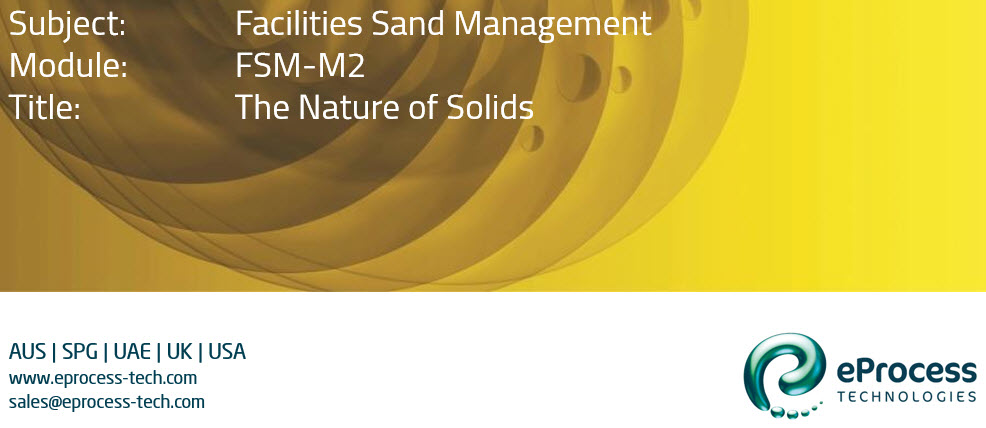Facilities Sand Management: Key Items and References (B-FSM033)

This is the last article from the Facilities Sand Management (FSM) training Module 2 entitled “The Nature of Solids”. Below is a summary of key items and references from articles B-FSM-001 through B-FSM-032.
Key Items
- All oil & gas wells produce sand (B-FSM-001)
- Inclusionary sand management can increase hydrocarbon flow (B-FSM-002)
- Sand is solid particles that are separable in facilities equipment (B-FSM-007)
- Natural and artificial solids have different properties (B-FSM-008)
- Sample size, amount, and method is critical for FSM design (B-FSM-009/010)
- Apparent density, PSD, and volume packing are key properties (B-FSM-021)
- Concentration, density, and settling rate calculations (B-FSM-022/023/024)
- Solids transport in piping, and valve & instrument selection (B-FSM-026 to -030)
References
- Brown, C.E., Neustadter, E.L., “The wettability of oil/water/silica systems with reference to oil recovery”, Journal of Canadian Petroleum Technology, July-September, 1980, pp. 100-110.
- Bumiller, M., “The Importance of Particle Shape (presentation)”, Horiba Scientific, 2013.
- Clift, R., Grace, J.R., Weber, M.E., “Bubbles, Drops, and Particles”, Dover Publications, Mineola, NY, USA, 1978.
- Davies, J.T. 1987. “Calculation of Critical Velocities to Maintain Solids in Suspension in Horizontal Pipes”, Chemical Engineering Science, Vol. 42, No. 7, pp. 1667-1670.
- Dubey, S.T., Doe. P.H., “Base number and wetting properties of crude oils”, SPE Reservoir Engineering, August, 1993, pp. 195-200.
- Ethington, E.F., “Interfacial Contact Angle Measurements of Water, Mercury, and 20 Organic Liquids on Quartz, Calcite, Biotite, and Ca-Montmorillonite Substrates”, USGS-OFR-90-409, U.S. Geological Survey, Golden, Colorado, July 1990.
- Green, D.W. and Perry, R.H. 2008. Perry’s Chemical Engineers’ Handbook, 8th Ed. New York: The McGraw-Hill Companies, Inc. (Chapter 6).
- Han, G., Dusseault, M.B., Cook, J., “Why Sand Fails After Water Breakthrough”, paper ARMA/NARMS 04-505, 6th North American Rock Mechanics Symposium, Houston, TX, June 5-9, 2004.
- Malvern Instruments Limited, “A Basic Guide to Particle Characterization, 2012.
- McLaury, B.S., and Shirazi. S.A. 1999. “Generalization of API RP 14E for Erosive Service in Multiphase Production”. Paper 56812 presented at the SPE Annual Technical Conference and Exhibition, Houston, Texas, 3-6 October.
- Rawlins, C.H., “Design of a Cyclonic Solids Jetting Device and Slurry Transport System for Production Systems,” paper 166118-MS, SPE Annual Technical Conference and Exhibition, New Orleans, LA, Sep 30-Oct 2, 2013.
- Smart, J.S., 2009. “Flow Velocity Required for Solid Particle Movement in Oil & Gas Pipelines”, Corrosion 2009 Conference & Expo, NACE International, paper 09469.
- Turian, R.M., Hsu, F.-L., Ma, T.-W. 1987. “Estimation of Critical Velocity in Pipeline Flow of Slurries”, Power Technology, 51, pp. 35-47.
- Vaziri, H., Barree, B., Xiao, Y., Palmer, I., Kutas, M., “What is the Magic of Water in Producing Sand?”, paper 77683, SPE Annual Technical Conference and Exhibition, San Antonio, TX, 29 September-2 October, 2002.
- Webb, P.A., “Volume and Density Determinations for Particle Technologists”, Micromeritics Instrument Corp., February 2001.
- Wilson, K.C., Addie, G.R., Sellgren, A., Clift, R. 2006. “Slurry Transport Using Centrifugal Pumps, Third Edition”, Springer, New York, NY.
The next article will start module M-3 on “Solids Handling”.
